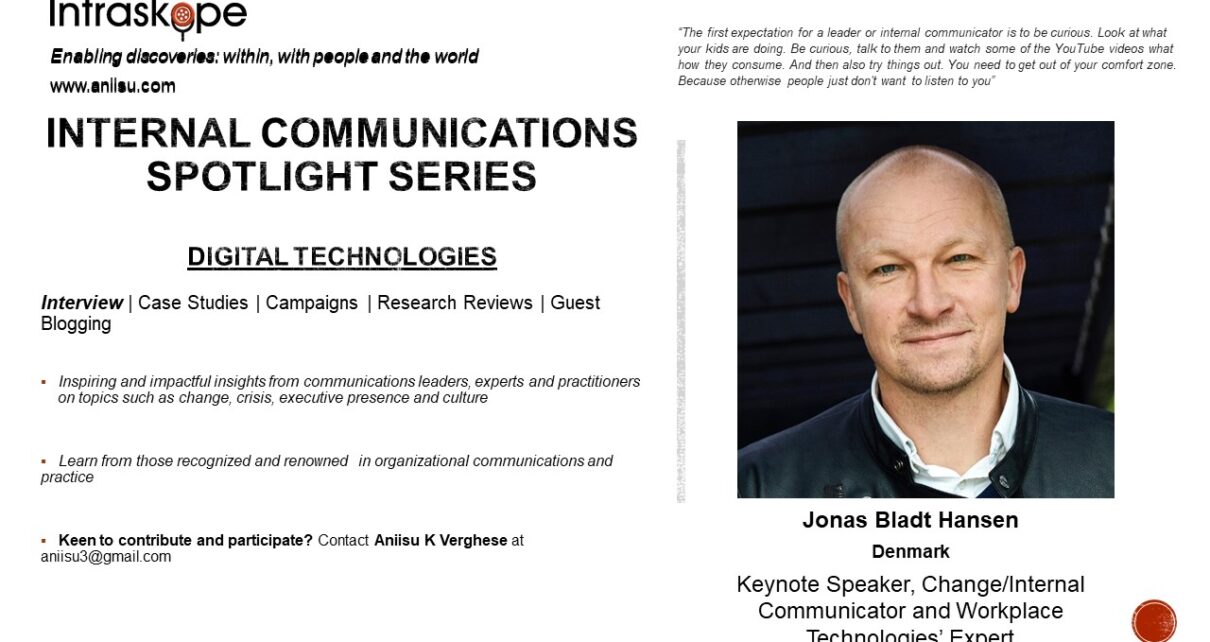With the proliferation of digital technologies in internal communications, it can get tough to make sense of what and how to manage these critical resources. More so, with the shift to online mode of communication during the pandemic, most organizations were struggling to balance human touch with digital reach. In this chat with Jonas from Denmark, who describes himself as a ‘tech savvy humanist helping organizations create inspiring digital workplaces where people love to show up, we cover a range of themes. These include the role of internal communicators, making sense of options available, gaining attention in a distracted world and learning from influencers and those innovating in content marketing. Do watch this interview to learn more about making the most of digital technologies at the workplace.
Welcome to the 25th edition of Intraskope’s Spotlight Series featuring Jonas Bladt Hansen, a keynote speaker, change and internal communicator, social media trainer and workplace technologies’ expert based in Denmark. He runs Inversus and helps organizations create workplaces where people love to show up. As part of his work, he finds and implements communication and collaboration platforms such as intranets, internal social media or Microsoft365; facilitates peer learning groups in Europe focusing on employee experience and internal communication and as a keynote speaker and facilitator he shares insights about the latest technologies and what new opportunities this offers for your workplace.
In this interview, I spoke to Jonas about the role of digital technologies and how internal communicators and leaders can make the most of these collaborative and connection platforms.
Watch this interview with Jonas to learn more.
In the Spotlight on Internal Communications Series, I talk to thought leaders on topics interrelated with internal communications such as culture, crisis, change, executive presence and leadership. The goal is to help unravel why they matter, what can leaders and communicators learn from experts and how we can put insights to practice.
Jonas Bladt Hansen
- What makes digital technologies crucial for internal communications?
if you’re an internal communicator, it’s really crucial for you to reach people with digital technologies. And that’s something we always dream off – meeting everyone in organizations. it’s also a great opportunity to engage people, for us to be better connect people. In the end, it’s about creating impact. So that is why digital technology is important. Digital has proven its worth so I don’t think we can live without it anymore.
2. With numerous channels available today, how do organizations and communicators make sense of what is the best solution?
If we go 50 years back in time, we had say one or two channels. Its a different situation, because we have evolved from a time when we thought ‘one size fits all’. Now we have the opportunity to choose between many options and how to make a difference to people. Next. If you have these channels available, you have options. We have to change. There is confusion that exists in organizations that they have so many channels available now. How do I split my time and choose or figure out where the news come from and so on. That’s a good problem to solve and it’s about figuring out how the content fits to the audiences. So switching channels based on the audience and how they receive and engage with the content matters. For instance, a podcast might work very well for salespeople who are out of office while an article might work well for people who are sitting in the office. People have different ways of consuming content and we need to serve those needs.
3. How can internal communicators become stronger with understanding the value of digital technologies?
Very often, we find ourselves be being too focused on producing output and reaching people. So, producing an article or podcast video, whatever we have. And when that’s done, we look at new vanity metrics. I would like I would really like us to change our focus on something different. I mean, obviously, we have to reach people otherwise there’s nothing else to talk about. But we also have to look at how can we engage with content or with each other based on what we can offer. So that I think that it’s really interesting to look at you that way and then also try to connect it with the outcomes, the business outcomes. So what is that we are doing? And how does it affect the business outcomes? We can end up producing podcasts for the HR team who are working with onboarding for instance, or whatever makes sense. Because I think our communication delivers business value,
4. There is a shift to more ‘human’ communication despite on the contrary a proliferation of digital and online solutions that are available inside organizations. How does a communicator balance this?
if we just look at the last two years we’ve been through, and then I think we can be sometimes more human when we are connected digitally, For example, in Teams meeting can be actually more human than a meeting in the meeting room because you ger to see the person in a personal setting – in the living rooms sitting in my kids’ rooms and so on. It also requires internal communicators to try and look at how can we facilitate better conversations for instance, on internal social media. It is an opportunity to engage people by helping them connect with each other – they might be working in the same organization but, far away from each other. We would benefit from connecting with each other and talk with each other and share ideas. And suddenly innovation much faster. So how can they connect so that ideas are fostered, and we become more innovative? It is a challenge for us is to understand how social media works and how we can use it in a strategic way. That is something I don’t see very often in organizations right now. However, that’s a really good opportunity. One of my clients is also talking about a podcast as an opportunity for people to engage with each other in a new way. So for instance, the podcast leads to connecting with the host or other listeners or to read an article or be a guest on the podcast or whatever makes a deeper kind of connection. So some opportunities to do something a different way and, in the future,
5. What are the best practices you have seen among some of your clients when it comes to using digital technologies?
Let’s start with how the best results actually happen. When people just go out and try out stuff, we can see what happens. That’s where I’ve seen some great examples of work becoming really, really engaging. It doesn’t always have to be come from the internal comms side – it will come from the organization. We just have to get it amplified. I have seen a good example in Denmark of a mobile company where they managed to combine a lot of aspects into one mobile app to serve business outcomes. They asked what do the salespeople in the stores need? To know? They knew that if they could give them the information they needed faster in a more engaging way, they might end up delivering a better customer experience and more sales. So they sent messages on the app from the CEO on a frequent basis. They sent our quizzes where people could answer questions about the latest Samsung telephone or whatever it was, and if they answered some of the questions in a wrong way, they might actually end up the theme, receive a new training video about those aspects. I think that was a great example of how you can combine learning with internet applications and so on. Digital technologies don’t care about silos or internal communications or HR communications learning. So you can create feeds from external into your internal intranet. You can create feeds wherever you follow. The next evolution is just coming up – about channels and managing them.
6. What is your advice for leaders who are often very reluctant to use digital technologies, especially if they belong to an older generation?
The first expectation for a leader or internal communicator is to be curious. Look at what your kids are doing. Be curious, talk to them and watch some of the YouTube videos what how they consume. And then also try things out. You need to get out of your comfort zone. Because otherwise people just don’t want to listen to you. I suggest in video, a five-minute article about the latest spreadsheets to figure out how to get attention today. I have a good example if I can share that from my vacation where my youngest son came to me late in the evening and he really insisted that I have to watch this video from Mr. Beast, a very famous YouTuber doing interesting stuff. And this video was about how the Mr. Beast helps clean beaches. And we watched this video and he had millions and millions of views and I saw how the video format has changed over time how I actually have neglected that. If you look at the way he’s producing, with visuals, very short clips all the time. There’s no waste of time. And if you’re used to a corporate video, you will instantly see a boring copy as they are today. So, if he wants to get attention, then we have to step up. We have to work with more visuals. We have to we have to figure out how can we make these things work. We need to say, let’s see what’s out there and then consider how can we how share Office 365 tips instead of the dreadful tutorials for 15 minutes. It’s here you can skip one step at a time for 10 seconds. And get surprised how much how much inspiration we get in 10 seconds to five minutes. This might be a bit over the top, but maybe there’s some elements.
Watch the complete video interview on YouTube or read the complete transcript above.
Missed the earlier episodes? Watch them here: D. Mark Schumann (Culture), Peter Yorke (Executive Presence), Sia Papageorgiou (Leadership Communications), Dianne Chase (Strategic Storytelling), Gloria Walker (Communication Planning), Rebecca Sangster-Kelly (Stakeholder Management), Ray Walsh (Localizing Employee Communications), Prof. Matt Tidwell (Reputation), Geri Rhoades (Manager Communications), Erik K Meyers (Business Acumen), Russell-Olivia Brooklands (IC Practice Governance), Paul Barton (Public Speaking and Business Communication), Cyrus Mavalwala (Digital Communication), Elvera N Makki (Social Impact Communication), Philippe Borremans (Communication Preparedness) and Magdalena Petryniak (Influence in Communications), Priya Bates (Communicating Diversity & Inclusion), Zora Artis (Communication Alignment), Diana Bonczar (Communication Execution), Jane McConnell (Gig Mindset), Paul Mathews (Trust & Communications), Brad Whitworth (Creativity in Communication), Zane Ewton (Podcasting) and Andrea Greenhous (Employee Experience).
You can also look up the ongoing Intraskope’s Spotlight on Internal Communication Series featuring practitioners from around the globe sharing best practices and perspectives.
Liked the interview? Post your comments and share it with your network.
Keen to participate in the ongoing series on Personal Branding, Crisis Communications, Internal Communications or CSR Communications? Drop me a note at aniisu3@gmail.com
Here are Internal Communications resources you can use:
- Learn: Internal Communications Fundamentals Course on Thinkific
- Internal Communications Series: https://forms.gle/KcqmPzLwq7NQi5Km6
- Chat with Aniisu – Internal Communications: https://www.instamojo.com/intraskope/connect-with-aniisu-60-minute-personalized-d/?ref=store
- Internal Communications workshops: https://bit.ly/2zdBRl1
You can also visit my website www.intraskope.com and You Tube channel to know more about my work.
#IC #digital #internalcomms #digitech #socialmedia #internalsocialmedia #curiosity #experience #onlinecomms #leadercomms #connection #podcasts #changecomms #Ipurpose #internalcomms #communications #internalcommunications #covid19 #JonasBladtHansen #focus

